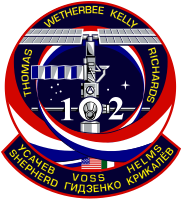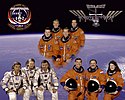STS-102
 | |
| Dane misji | |
| Indeks COSPAR | 2001-010A |
|---|---|
| Zaangażowani | |
| Oznaczenie kodowe | STS-102 |
| Pojazd | |
| Wahadłowiec | |
| Załoga | |
 U góry załoga wahadłowca (od lewej): James Kelly, Andrew Thomas, James Wetherbee, Paul Richards. Po lewej załoga 1. stacji (od lewej): Sergiej Krikalow, William Shepherd, Jurij Gidzenko. Po prawej załoga 2. stacji (od lewej): James Voss, Jurij Usaczow, Susan Helms. | |
| Dowódca | |
| Start | |
| Miejsce startu | |
| Początek misji | |
| Orbita okołoziemska | |
| Apogeum | 381 km |
| Perygeum | 370 km |
| Okres orbitalny | 92,06 min |
| Inklinacja orbity | 51,5° |
| Lądowanie | |
| Miejsce lądowania | KSC, pas startowy 15 |
| Lądowanie | |
| Czas trwania misji | |
| Przebyta odległość | 8,5 mln km[3] |
| Liczba okrążeń Ziemi | |
| Program lotów wahadłowców | |
STS-102 (Space Transportation System) – dwudziesta dziewiąta misja wahadłowca Discovery agencji NASA i sto trzecia programu lotów wahadłowców, w czasie której dokonana została wymiana załóg Międzynarodowej Stacji Kosmicznej[4].
Załoga
- źródło[4]
- James D. Wetherbee (5)*, dowódca
- James M. Kelly (1), pilot
- Andrew Thomas (3), specjalista misji 1
- Paul W. Richards (1), specjalista misji 2
Przywieziona załoga 2 ISS
- Jurij W. Usaczow (4), dowódca ISS (Rosja)
- James S. Voss (5), inżynier pokładowy ISS
- Susan J. Helms (5), oficer naukowy ISS
Odwieziona na Ziemię załoga 1 ISS
- William M. Shepherd (4), dowódca ISS
- Jurij P. Gidzenko (2), dowódca Sojuza (Rosja)
- Siergiej K. Krikalow (5), (Rosja/RSA) inżynier pokładowy ISS
- *(liczba w nawiasie oznacza liczbę lotów odbytych przez każdego z astronautów)
Parametry misji
- Masa:
- startowa orbitera: 99 503 kg
- lądującego orbitera: 90 043 kg
- ładunku: 5760 kg
- Perygeum: 370 km[5]
- Apogeum: 381 km[5]
- Inklinacja: 51,5°[5]
- Okres orbitalny: 92,06 min[5]
Cel misji
Ósmy lot promu kosmicznego na stację kosmiczną ISS – transport zapasów w kontenerze Leonardo MPLM i powrót pierwszej załogi orbitalnej (Shepherd, Krikalow, Gidzenko – start w październiku 2000 r. na pokładzie rosyjskiego statku Sojuz TM-31, 140 dni 23 godz. 39 min w kosmosie), którą zastąpiła załoga druga (Usaczow, Voss, Helms)[4].
Dokowanie do ISS
- Połączenie z ISS: 10 marca 2001, 06:38:00 UTC[2]
- Odłączenie od ISS: 19 marca 2001, 04:32:00 UTC[2]
- Łączny czas dokowania: 8 dni, 21 godz., 54 min
Spacer kosmiczny
- EVA -1 (11 marca 2001, 8 godz. 56 min): J. Voss, S. Helms
- EVA-2 (13 marca 2001, 6 godz. 21 min): A. Thomas, P. Richards
Zobacz też
Przypisy
- ↑ a b c Adam Chen, William Wallack, George Gonzales: Celebrating 30 Years of the Space Shuttle program. NASA, 2012. ISBN 978-0-16-090202-4.
- ↑ a b c d e f Spaceflight mission report: STS-102 (ang.). Spacefacts. [dostęp 2017-07-27].
- ↑ a b podsumowanie misji STS-102 na stronie KSC (ang.)
- ↑ a b c Tomaš Přibyl: Dzień, w którym nie wróciła Columbia. Bielsko-Biała: DEBIT, 2003, s. 175.
- ↑ a b c d Mark Wade: STS-102 (ang.). W: Encyclopedia Astronautica [on-line]. [dostęp 2017-07-27].
Linki zewnętrzne
- podsumowanie misji STS-102 na stronie KSC (ang.)
- Mark Wade: STS-102 (ang.). W: Encyclopedia Astronautica [on-line]. [dostęp 2017-07-27].
- Spaceflight mission report: STS-102 (ang.). Spacefacts. [dostęp 2017-07-27].
Media użyte na tej stronie
The flag of Navassa Island is simply the United States flag. It does not have a "local" flag or "unofficial" flag; it is an uninhabited island. The version with a profile view was based on Flags of the World and as a fictional design has no status warranting a place on any Wiki. It was made up by a random person with no connection to the island, it has never flown on the island, and it has never received any sort of recognition or validation by any authority. The person quoted on that page has no authority to bestow a flag, "unofficial" or otherwise, on the island.
With the full-time occupancy of the International Space Station (ISS), Space Transportation System crew portraits have taken on a new look, as depicted in this composite scene. These ten astronauts and cosmonauts represent the base STS-102 space travelers, as well as the crew members for the station crews switching out turns aboard the outpost. In the top group are, from the left, astronauts James M. Kelly, pilot; Andrew S.W. Thomas, mission specialist; James D. Wetherbee, mission commander; and Paul W. Richards, mission specialist. The bottom left grouping is the Expedition One crew, which includes, from left, cosmonaut Sergei K. Krikalev, flight engineer; astronaut William M. (Bill) Shepherd, commander; and cosmonaut Yuri P. Gidzenko, Soyuz commander. At bottom right is the crew who will replace Shepherd and his collegues aboard the station, from the left, astronaut James S. Voss; cosmonaut Yury V. Usachev, Expedition Two commander; and astronaut Susan J. Helms. Usachev, Krikalev and Gidzenko all represent the Russian Aviation and Space Agency.
The STS-102 crew insignia depicts the International Space Station as it looked when Space Shuttle Discovery was docked. Visible elements include the P6 and Z1 trusses, solar arrays from the Russian segment, 2 Pressurized Mating Adapters, and the Multi Purpose Logistics Module that was temporarily attached to the underside of the Unity Node. The numbers "102" represent the mission tail number. The red, white, and blue ribbons surrounding the space station represent that this is a crew rotation flight. The colors represent the nationalities of the crewmembers (Russian and American). Underneath the ribbons are the flags of the three nations who are the major contributors to the mission (from left to right: Russia, United States, Italy). The names of the 4 permanent crewmembers are displayed in gold around the top of the emblem. Attached to the bottom are six names depicting the six rotating crewmembers (Expedition 2 on top and Expedition 1 on bottom).




